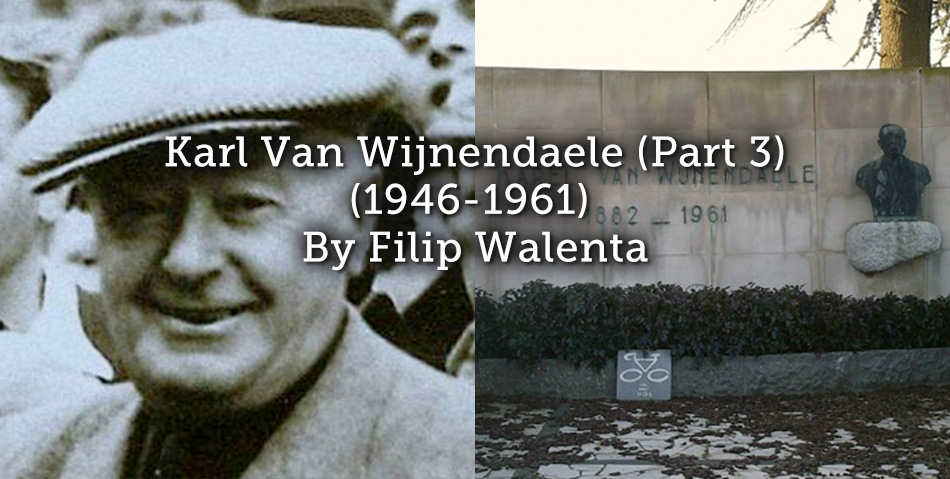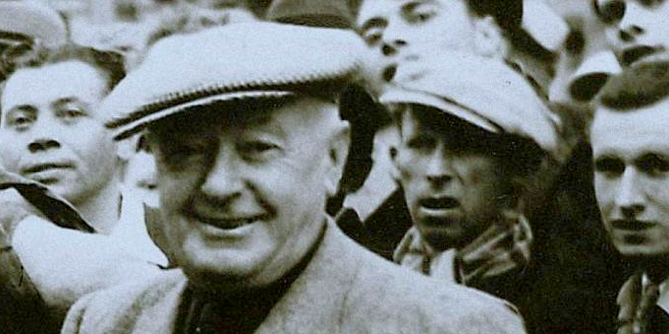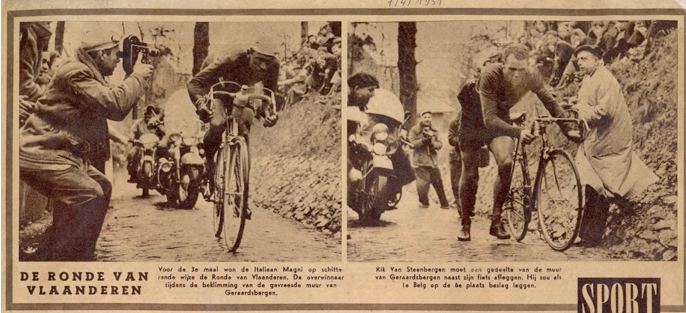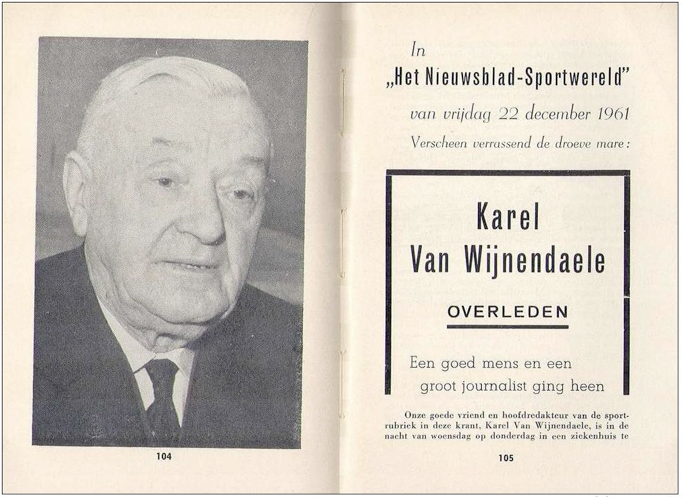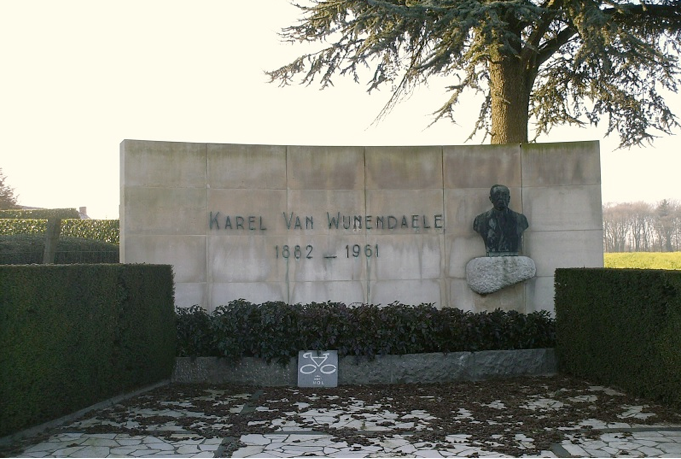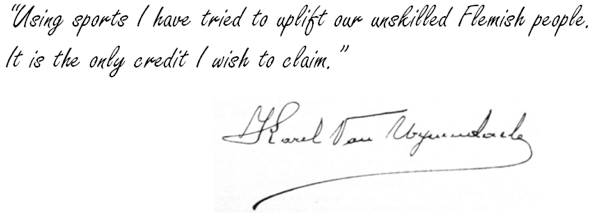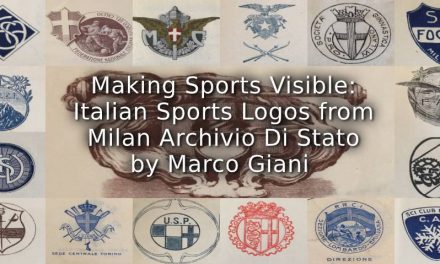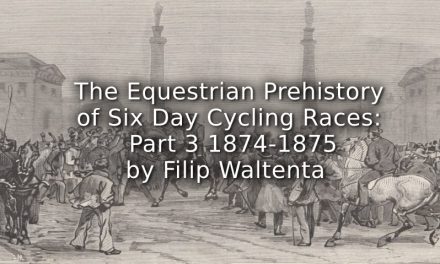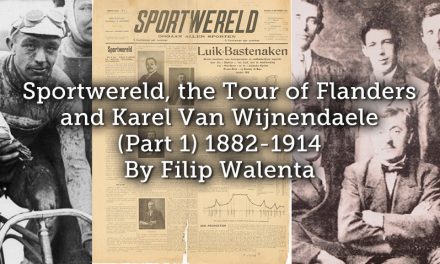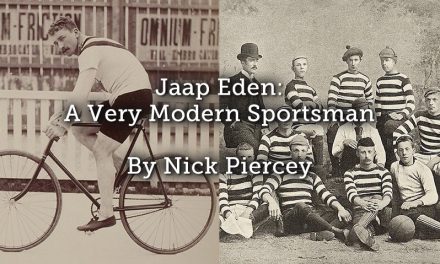Article © Filip Walenta
After the repression Karel Van Wijnendaele was restored on 14 November 1948 and decorated with the medal of honor for 25 years of loyal service to the Belgian cycling union KBWB, and on 6 April 1952 he was decorated with the Knights Cross of the Order of (King) Leopold by the Minister of Health Alfred De Taeye. A year later he was celebrated as honorary citizen of his hometown, Torhout.
INTERNATIONAL NOTORIETY
Karel Van Wijnendaele was very highly regarded in the international cycling world. For example in the Netherlands he was highly respected for his conciliation with the organizer of the Tour de France, Henri Desgranges, in getting starting right for the Dutch national team in 1936. Regularly he was invited by the Dutch radio broadcast and press for interviews about international cycling news.
In 1951 Jacques Goddet, the successor of Henri Desgrange, declared in an article in Sportwereld that the impact and advice of Karel was of significant importance to the international growth of the Tour de France.
When at 6 July of that year the third stage of the Tour took off in Ghent the official start of the race by the pace car was given at Villa Sportwereld in Sint-Martens-Latem, the house of Karel Van Wijnendaele.
THE TOUR OF FLANDERS – A CYCLING MONUMENT
In 1947 the Challenge Desgrange-Colombo, the forerunner of the ranking criterion UCI Pro Tour was founded in order to protect the classic races. The most important one day races like Milan-San Remo, Paris-Roubaix, La Flèche Wallonne, Paris-Brussels, Paris-Tours, the Tour of Lombardy and the Tour of Flanders were included together with the long distance races Tour of Italy and the Tour de France. The Tour of Switzerland (1949), Liège-Bastogne-Liège (1951) and the Vuelta (Tour of Spain)(1958) followed a couple of years later.
- Tour of Flanders 1951 at the Muur (Wall of) van Geraardsbergen (Source : Sportwereld, 7 April 1951) Left : three times in a row winner Francesco Magni (1949, 1950 and 1951) Right : Rik Van Steenbergen, winner of the Tour of Flanders in 1944 and 1946
During the sixties the condition of the roads improved significantly as the cobbles were replaced by concrete and tar macadam. In order to keep the degree of difficulty in the race more and more the centre of gravity of the Tour of Flanders was replaced to the Flemish Ardennes where the amount of climbs increased consistently from five in 1960 to more than fifteen in the nineties. From 1998 a passage along the coast line was inserted again as the race started in Bruges.
End 2008 the Tour of Flanders was sold to the holding of Wouter Vandenhaute, former sports journalist of the Belgian broadcast, and together with the other Flemish pro-cycling races like the Omloop Het Nieuwsblad, Gent-Wevelgem, Dwars door Vlaanderen, the Scheldeprijs and the Brabantse Pijl it was united in the project Flanders Classics.
In 2012 the final of the course was redesigned and from 2017 the start of the Tour was sold to Antwerp for five years for the prize of two million Euro (1.778.000 £). Both important changes and restyling of the course upset many fans and followers. Several villages were disappointed because they lost their free commercial TV-interest and organizers of VIP arrangements had to search for new locations along the course.
EPILOGUE
Unless doctor advice and urgent appeal of the family Karel stubbornly followed the Tour de France in 1961, but sickness and exhaustion forced him to return homewards halfway the race. It would be the last time he followed his favorite long distance cycling race.
Karel Steyaert had celebrated his 79th birthday when he died on 21 December 1961 in a hospital in Deinze.
Two days later he was buried in the communal cemetery of Sint-Martens-Latem in the presence of the whole international cycling world.
- “In Het Nieuwsblad-Sportwereld of Friday 22 December 1961 the sad words were written : Karel Van Wijnendaele passed away. A good man and a great journalist has gone.”
GONE BUT STILL PRESENT
On 4 April 1964 on the top of the Kwaremont, a monument was inaugurated to the remembrance of Karel Van Wijnendaele and in Sint-Martens-Latem, the village where he spent the last twenty two years of his life a street was named after him, the Karel Van Wijnendaelelaan.
- Karels monument on top of ‘his’ Kwaremont, the first hill he introduced in the track of the Tour of Flanders.
On 25 August 1962 the first Karel Van Wijnendaele Trophy, a cycling race for semiprofessionals, was organized in the town Karel was born, Torhout.
From 1979 till 2015 it was yearly organized as a recreational cycling event with start and finish in Sint-Martens-Latem. The whole final part of the pro-cycling race with a distance of more than two hundred kilometers including all the climbs was followed. The Trophy was very popular in the recreational cycling world, more than thousand cyclists from all over the country participated every year. And for cycling fans from the surrounding countries (UK included) it was the sporting goal of the year to follow the footsteps of their heroes and to experience the pain in their body and muscles on the climbs and the cobble roads.
In 1991 a short documentary of the Trophy was shown in the TV sports program Sportweekend. It was made by Wouter Vandenhaute, later from 2009 owner and organizer of the Tour of Flanders (see video).
The Project Karel Van Wijnendaele was founded short after an expo about his life in 2014.
https://www.youtube.com/watch?v=Fq1spI-WiL4(+ interview of English participants)
THE INHERITANCE
Without any doubt Karel Van Wijnendaele was the most important pioneer of Flemish sports journalism and one of the best sports journalists the Flemish sports press had ever known. He wrote more than 11.000 articles and remained auditor-in-chief of Sportwereld until his death.
His efforts to the globalization of cycling and the founding of the forerunner of the UCI Protour in the fifties were the foundations of the increasing popularity of the sport in the whole world and in Belgium in particular.
But above all his most important achievement was his dedication to the education of the Flemish labor people.
It cannot be better described than by a letter from an unknown male that the newsroom of Sportwereld received a few days after Karels death.
“Would you be so kind to convey my condolences and deepest sympathy to the family of Karel Van Wijnendaele.
I am eternal grateful to Karel because he learned me how to read. The curiosity to know more about our Belgian cyclists and the desire to follow them in Sportwereld, where he used to write his real life articles, pushed me to learn how to read and later how to write.
I have to thank Karel for my cultural development that gave me another look upon the world and made me a better human being.”
And Joris Jacobs, a sports journalist of Sportwereld, wrote:
“In my neighborhood there was this man who worked in the factories of Liège that could not read nor write. In the train he always overheard his colleagues talking about all the stories they had read in the articles that Karel had written in Sportwereld.
In the early thirties Sportwereld was the sports bible of the working class people.
The man felt so unhappy he could not read all these stories, that only for this reason he learned himself how to read.
He still cannot write, but by pointing his finger to the words, he reads every cycling article in Sportwereld.”

